Bayon Temple
Perhaps the spookiest or the most mesmerizing of the Angkor temples, the center piece of Angkor Thom – Bayon – looks like nothing much from a distance. However, once inside, you realize that Bayon is constructed around 54 towers, with 216 smiling faces of Avalokiteshvara peering down at you. Bayon is a fantastic temple to explore – with mazes of tunnels, blocked doorways and tumble-down rocks making it a perfect place to get lost in the mysteries of Angkor.
Bayon is 45m high and has three levels linked by stairs and small yards. The galleries on the first and second level have historical and religious bas-reliefs. The third level has a central circular tower, which is unique in Khmer Architecture.
Here is everything about Bayon Temple
Baphuon
Baphuon is located 200m west of Bayon and was marked as the center of the city when the whole of Angkor Thom was fully complete. A pyramidal representation of Mount Meru, at the time, it was probably one of the most impressive of the Angkor temples. A 200m elevated walkway leads to the temple which has a central tower 43m high.
Here is everything about Baphuon Temple
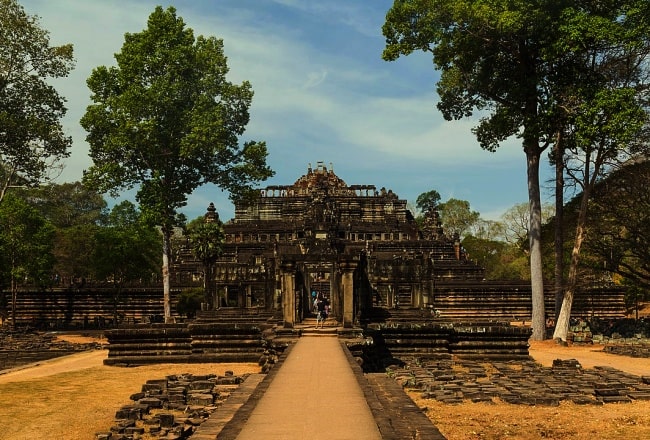
Terrace of the Elephants
The Elephants terrace was built by King Jayavarman VII at the end of the 12th century. The terrace stretches out over a length of more than 300 meters from the Baphuon in the South to the Leper King terrace to the North. The terrace is named for the sculptures in high relief of elephants and their mahouts. At several sections large elephant heads protrude out from the wall, their very long trunks forming pillars extending to the ground, similar to those of the gates of Angkor Thom.
The terrace was used as an audience hall and for public ceremonies. According to the accounts of Chinese diplomat Zhou Daguan the King appeared daily on the Elephants terrace to listen to the complaints and problems of the citizens of his Kingdom. The parade grounds in front of the terrace were used as the scene for several festivals, games, processions and parades of the Khmer army watched by the King from the Elephants terrace.
The Elephants terrace consists of inner and outer sections. The inner sections were built first and later became buried under the soil during construction of the outer sections. The well preserved inner walls contain numerous carvings of Apsaras, warriors and animals like multi headed horses. The Northern end of the outside walls contains carvings of sports, such as Polo games, wrestlers and chariot racing. The Central section of the terrace contains carvings of Garudas, Kinnarees and elephants engaged in a hunt, as well as depictions of the Buddha.
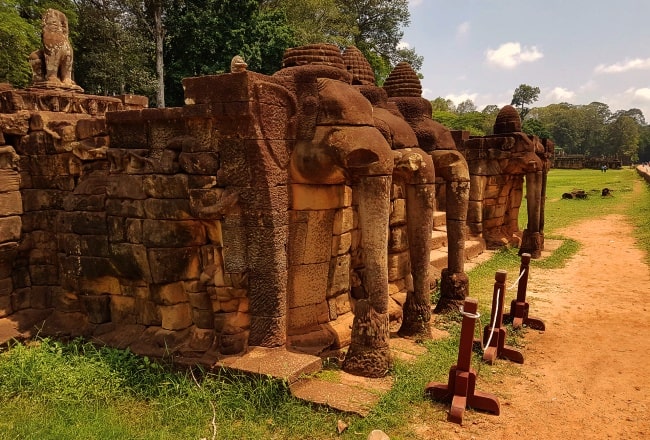
Terrace of the Leper King
The Leper King terrace is named after the “Leper King” statue that was found here. The terrace was built by Jayavarman VII in the late 12th century, directly North of the Elephants terrace.
The Leper King terrace is believed to be built as a representation of Mount Meru, the center of the universe in Buddhist and Hindu cosmology. The 25 meter long terrace is completely covered with sculptings in high relief. Long rows of seated finely carved figures, mainly of multi headed Naga snakes, armed guardians, Garudas and female celestial beings decorate the walls.
The terrace consists of inner and outer walls. The inner walls were built first and became buried under the soil when the outer walls were constructed. The inner walls contain well preserved sculptings of multi headed Naga serpents, demons, princes and princesses. The outer walls contain carvings like a Palace scene with a sword swallower and Shiva holding a trident.
The “Leper King” statue was found on top of the terrace. According to local belief, the statue was a depiction of King Yasovarman I, who was also known as the Leper King as he suffered from leprosy. It is now assumed that the statue might represent Yama, the God of death. The statue now sitting atop the Leper King terrace is a copy, the original is kept in a museum in Pnomh Penh. It is surrounded by three guardian figures armed with a club.
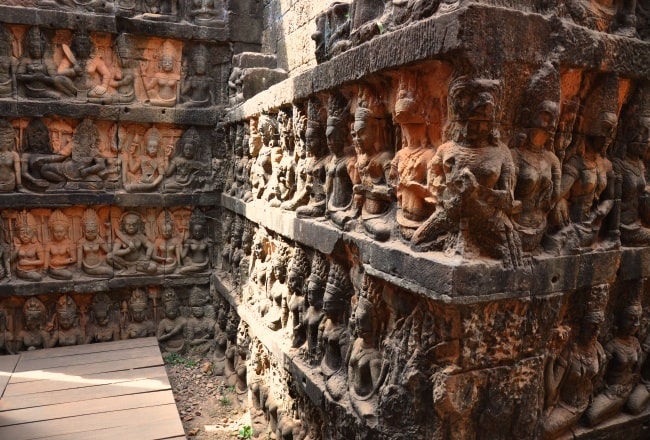
Preah Palilay
One of the loveliest temples in the Angkor Thom complex is Preah Paliliay in the north-west corner of the site. Quiet and atmospheric, it provides some great photo opportunities with huge trees looming over its structure.
Here is more detail about Preah Palilay
Phimeanakas
Phimeanakas is more interesting historically than visually. It used to house a Royal Palace, where bathing would take place (the pools are still apparent) but very little remains. However, a climb up its pyramidal structure gives nice views of the surrounding area.
Here is everything about Phimeanakas
Entrance gates to the city
The city is surrounded by high defensive walls, 3 kilometers long on each side. To the inside of the wall is an earth embankment, which allowed the Khmer good views of approaching enemy armies.
Access to the city was through five gopura gates, one at the center of each wall, an extra one (the Victory Gate) on the road from the Royal Palace to the East Baray. The gates were built between the end of the 12th century and early 13th century. The gopuras consist of a central tower, 23 meters in height, flanked by two smaller towers.

South Gate of Angkor Thom
The south gate of Angkor Thom is the best preserved. It is approached from outside via a causeway that extends about fifty meters across a moat. On each side of the causeway are railings fashioned with 54 stone figures engaged in the performance of a famous Hindu story: the myth of the Churning of the Ocean. On the left side of the moat, 54 'devas' (guardian gods) pull the head of the snake 'Shesha' while on the right side 54 'asuras' (demon gods) pull the snake's tail in the opposite direction. In this myth, the body of the snake is wrapped around the central mountain—Mt. Meru—perhaps corresponding here to the Bayon temple at the center of the site. In any case, the myth relates that as the Devas pulled the snake in one direction and the gods pushed in the other, the ocean began to churn and precipitate the elements. By alternating back and forth, the ocean was 'milked', forming the earth and the cosmos anew.
The central tower of the stone gate is capped by three face-towers that face the four directions (the central tower faces both out and in). Below them at the base of the gate are two sets of elephant statues that flank the entrance on both sides. Sitting on each elephant is a figure of the god Indra carrying his usual weapon, the vadra (a lightning bolt). The gate itself is shaped like an upside-down 'U' and is corbelled at the top (instead of arches, the builders of Angkor preferred to use corbelling to span distances). It is still possible to see where wooden doors once fitted to the gate through openings in the stone.
There is some debate as to the functionality of Angkor Thom as a whole. If it was a wall intended for defense, it was rather poorly designed, since there is nowhere along the wall for defenders to take refuge from incoming fire or shoot back from a shielded location. This is surprising since Angkor had been sacked in 1177 by Champa invaders, and one can readily imagine that its new King, Jayavarman VII would have been concerned with defense should the invaders return.
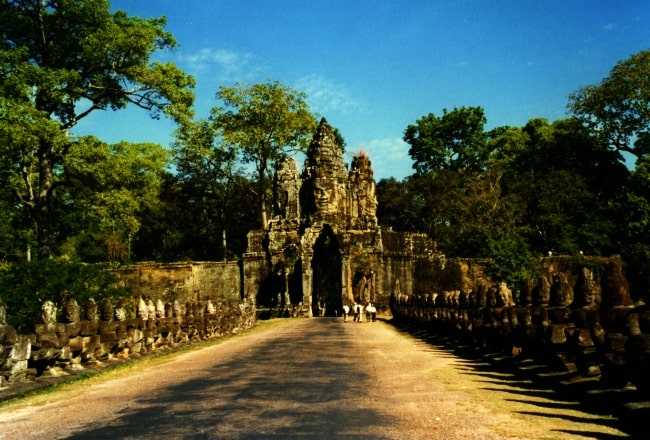
If not intended for defense, the walls may simply have been an additional enclosure around the Bayon temple, more for ceremony than for practical use. As in Southern India, the Angkor rulers built temples surrounded by walls, but usually not with walls as thick and grand as those of Angkor Thom.
East Gate of Angkor Thom
Jayavarman VII's 'Great City' (the meaning of Angkor Thom) enclosed an area of about 9 square kilometers and could only be entered through five gates. On the north, south, and west, only one gate provided access, whereas the east side enjoyed one gate leading to the royal palace (the so-called Victory Gate) and another gate to the south now known as the Gate of the Dead. Tradition holds that the name derives from the custom of the gate only being used when transporting a king to his funeral, but there is no historical evidence for this. More likely the gate simply served as the east entrance to Angkor Thom with the Victory Gate providing direct entry to the Royal Palace and surrounding environs.
The east gate of Angkor Thom was used as a location in Tomb Raider, where the bad guys broke into the ‘tomb’ by pulling down a giant polystyrene apsara. This is the most atmospheric of Angkor Thom's gates as there is no road here, just a jungle path leading to Chau Say Tevoda.
The architecture of the gate is very similar, if not identical, to that of the other gates.
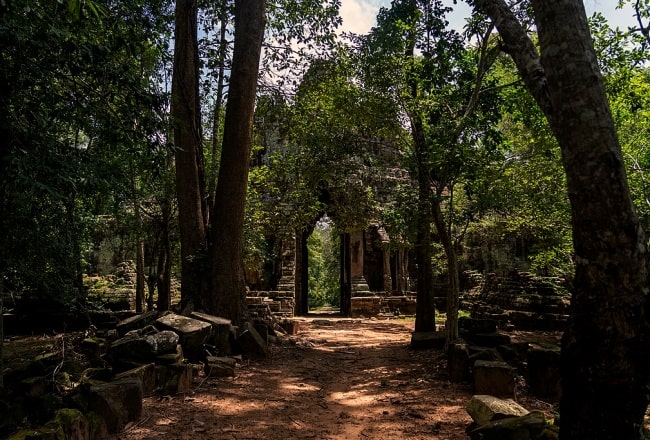
The giant faces on the towers
The towers, known as “face towers” similar to those at the Bayon, contain four very large heads on top of the gates facing each of the four cardinal directions. They are believed to represent Lokeshvara, the Bodhisattva of compassion. The central tower contains 2 faces looking in opposite directions; each of the smaller towers have 1 face each looking in one of the remaining two directions.
A great deal of knowledge about the history and daily life in Angkor was gained from the accounts of Zhou Daguan, a Chinese diplomat who lived in Angkor for a year until July 1297. According to him, there was a fifth head on the gopura’s top at the time, of which nothing remains today.
On the ground level of the gates on either sides of the entrance is a large sculpture of Airavata, the three headed mythological elephant with the God Indra sitting on his back. The opening of the gates are 7 meters high by 3½ meters wide in which there were originally massive wooden doors that were closed at night. Most visitors to Angkor Thom use the well preserved South gate, that was restored in the 1950’s.

Causeways crossing the moat
Crossing the moat to each of the city’s five gates is a causeway lined on either sides by stone figures holding a huge snake. The figures represent 54 Devas (a Hindu deity) on one side, 54 Asuras (demons battling the Devas) on the other side pulling a giant snake. This scene is associated with the storey of “The Churning of the Ocean of Milk”, an ancient Hindu story. The story tells that the ocean was churned by Devas and Asuras to extract from it the nectar of immortality. The snake Vasuki (King of the Nagas) served as the rope, Mount Mandara (probably represented by the Bayon temple) was used as the churning pole.
Prasat Chrung
At each of the four corners of the walls surrounding Angkor Thom is a small temple, named Prasat Chrung. The prasats can be reached by walking on the earth embankment inside the walls, starting from one of the entrance gates. The Prasat Chrung were built between the end of the 12th century and early 13th century, and were dedicated to the Bodhisattva Lokeshvara. The temples, decorated with sculpted Devatas, have a cruciform floor plan and a terrace next to it with a small pavilion. All four temples contained a stele, praising King Jayavarman VII. The four Prasat Chrung are in various states of repair.
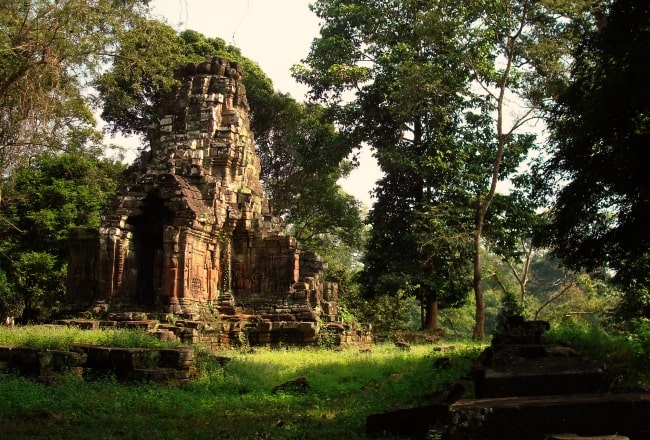
Prasat Suor Prat
The Prasat Suor Prat are a row of 12 towers, 6 on either side of the road leading from the Royal Palace to the Victory gate. The towers are found East of the Royal terraces, overlooking the parade grounds to the West.
Prasat Suor Prat literally translates to “towers of the rope dancers”. The purpose of the towers is not known. Their design and unusual North - South orientation, instead of the usual orientation either towards East or West, suggests that the towers were not built as sanctuaries.
Here is more detail about Prasat Suor Prat
Preah Pithu Group
To the North East of the Royal Palace is a group of five temple, known as the Preah Pithu Group. The temples found in a peaceful forest setting are mostly in a ruined state. No inscribed steles were found in any of the monuments with information about the founding of the temples, but it is assumed that they were built in the 13th century. Four of the temples are Hindu monuments, the largest one is a Buddhist temple, which was left unfinished.
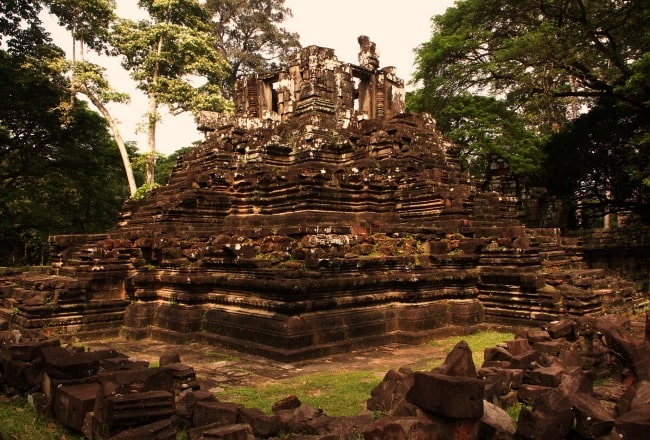
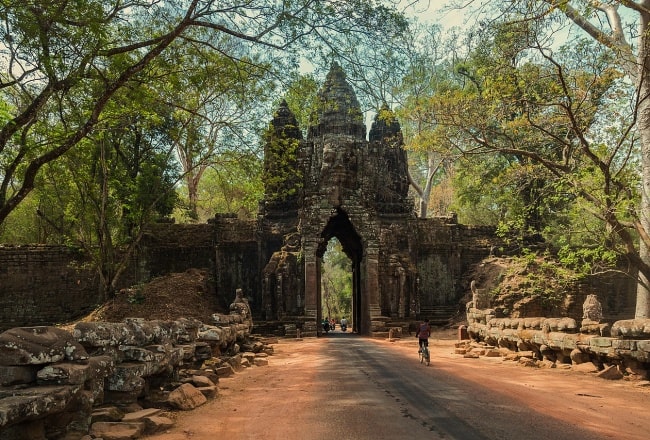


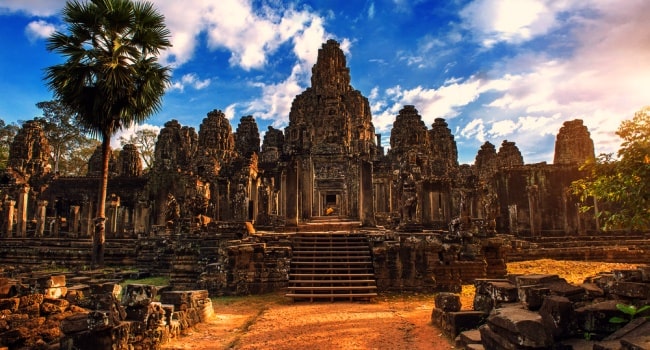

 21/12/2025
21/12/2025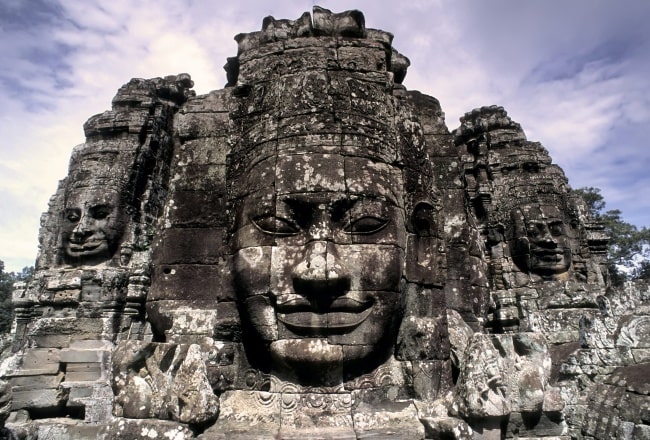
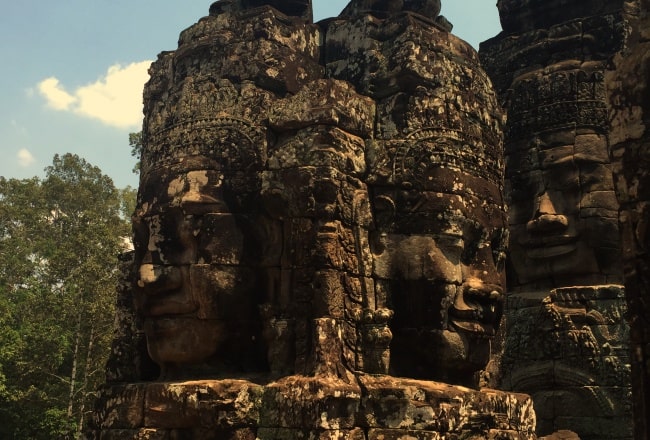
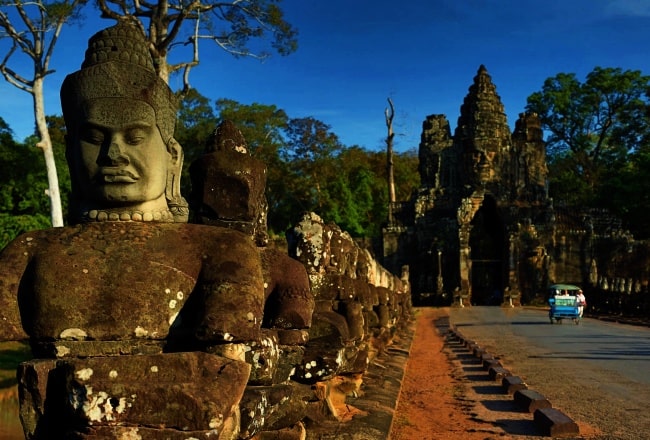
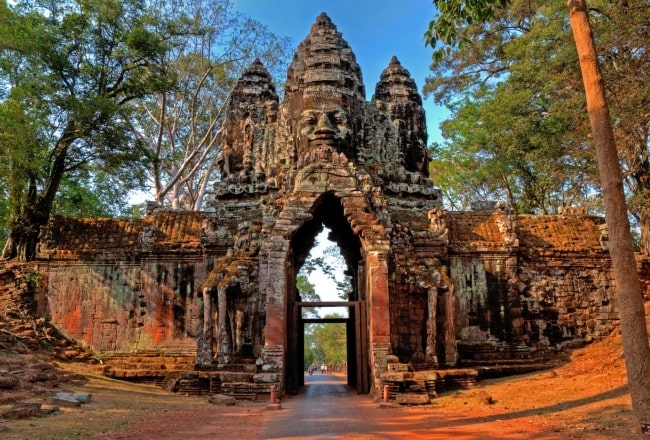
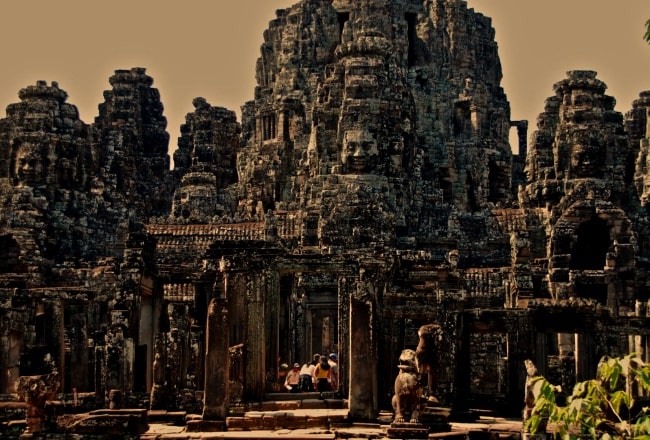









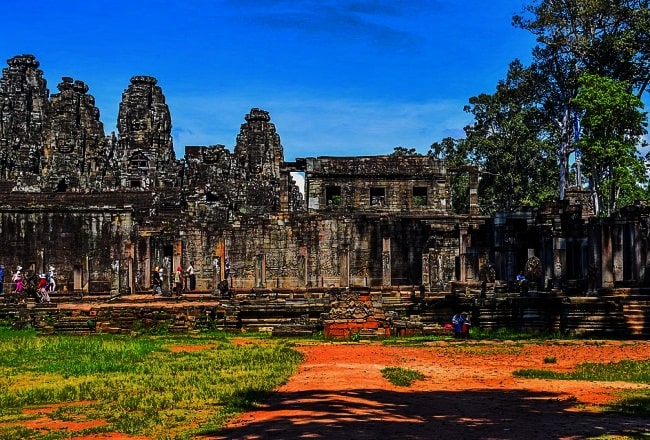
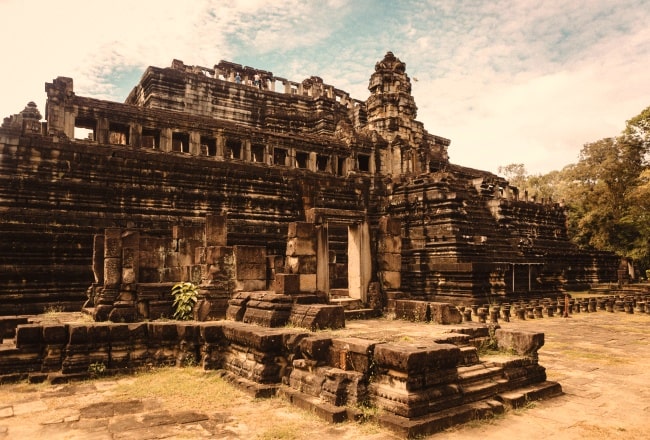
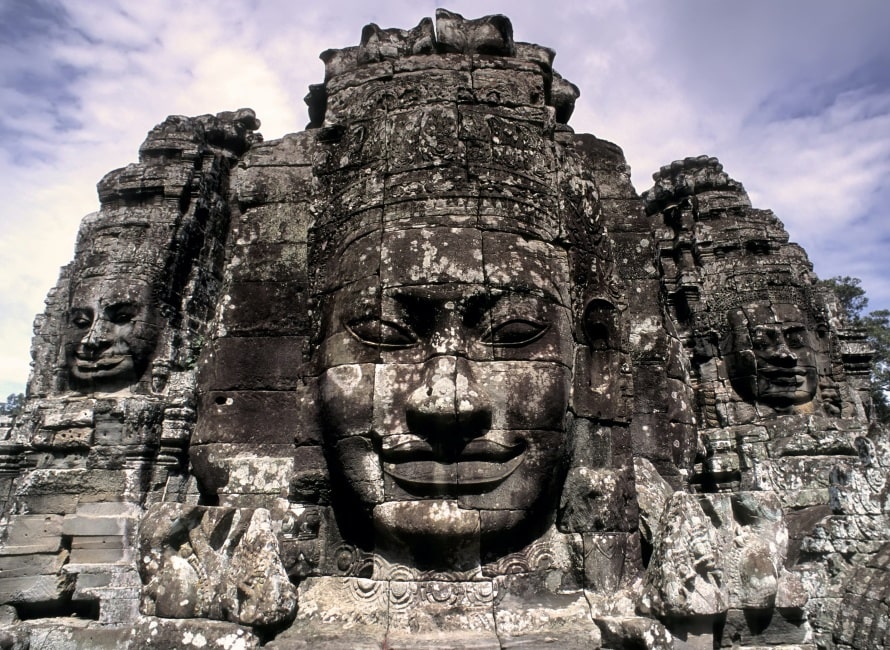

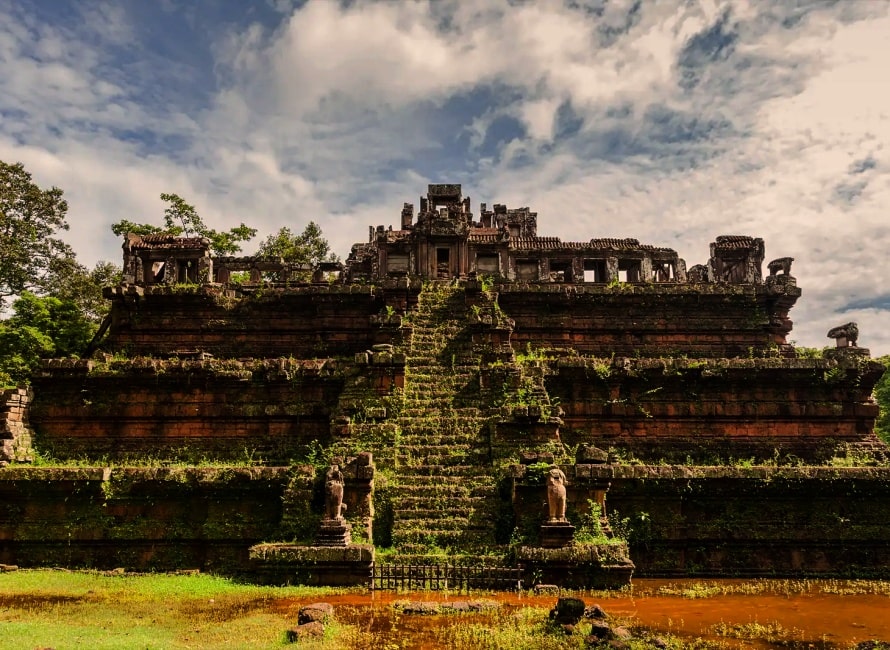


























Jolie LIEMMy name is Jolie, I am a Vietnamese girl growing up in the countryside of Hai Duong, northern Vietnam. Since a little girl, I was always dreaming of exploring the far-away lands, the unseen beauty spots of the world. My dream has been growing bigger and bigger day after day, and I do not miss a chance to make it real. After graduating from the univesity of language in Hanoi, I started the exploration with a travel agency and learning more about travel, especially responsible travel. I love experiencing the different cultures of the different lands and sharing my dream with the whole world. Hope that you love it too!